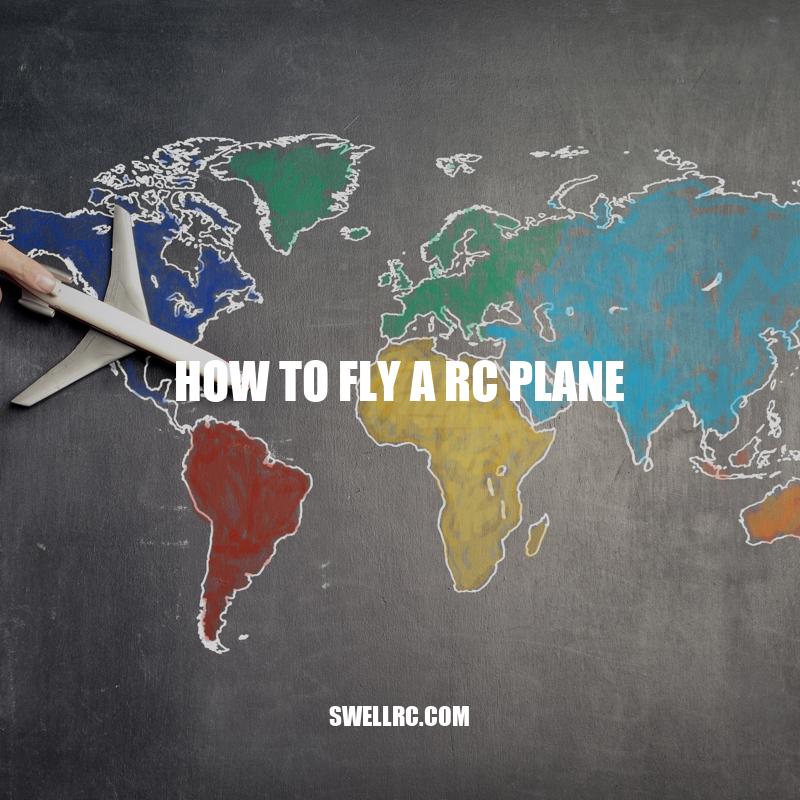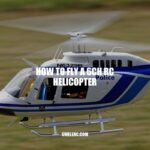How to Fly an RC Plane: A Beginner’s Guide
Remote-controlled (RC) planes provide an exciting and engaging experience for both hobbyists and aviation enthusiasts. Flying an RC plane can be a fun and fascinating activity that allows you to enjoy the thrill of building and operating a miniature airplane. But learning to fly an RC plane can be overwhelming, and even dangerous if you don’t have the proper knowledge and experience. It’s essential to understand the mechanics of an RC plane, the various types of planes available, and the basics of operation before you start flying. Additionally, you need to learn how to assemble and tune the plane to ensure that it is in good working order. In this article, we’ll provide you with practical tips and guidance on how to fly an RC plane safely and enjoyably. Whether you are a beginner or an experienced remote pilot, you’ll find useful information that will help you master the art of flying an RC plane. So let’s dive in and explore the exciting world of RC planes!
Types of RC Planes
Before you start flying an RC plane, it’s important to research the various types available and select the right one for your skill level and interests. Here are some of the most common types of RC planes:
- Trainers: Basic planes that are ideal for beginners due to their stable flying characteristics.
- Gliders: Planes that are designed to fly without a motor, relying on natural forces like wind and thermals to stay aloft.
- Park Flyers: Smaller planes that are designed to be flown in smaller spaces like parks or fields.
- Sport Planes: Planes that offer more advanced flying characteristics and features, such as aerobatic capabilities.
Researching different RC planes and selecting one that is right for your needs is an important first step in learning to fly an RC plane. Many websites offer in-depth information and reviews of different RC planes, such as RC Groups and RC Universe. Additionally, many hobby stores offer knowledgeable staff that can help you make an informed decision on which RC plane to choose.
How do you fly an RC plane for the first time?
If you’re a beginner, flying an RC plane can be overwhelming. Here are some basic steps to get started:
- Start with a trainer plane:
Choose an RC plane meant for beginners that comes with a controller. These planes are stable and easier to control, which will make it easier for you to fly.
- Find an open area:
Make sure you find a wide open space with no obstructions or people around.
- Make sure your plane is properly set up:
Before taking off, make sure your RC plane is properly set up. Check the battery, control surfaces, and make sure the plane is balanced.
- Practice takeoff and landing:
Try taking off and landing the plane a few times before attempting to fly it. This will help you get a feel for the controls.
- Start slow:
Don’t try to fly too fast or do any complicated maneuvers at first. Start by flying in a straight line and gradually getting more comfortable with the controls.
- Be patient:
Flying an RC plane takes time and practice to master. Don’t get discouraged if you crash a few times. Just keep practicing!
If you’re looking for more information or resources on flying RC planes, check out websites like hobbyzone.com or towerhobbies.com. They offer a variety of products and tips for beginners.
Operating the Remote Control
Once you have selected an RC plane that suits your needs, it’s important to get comfortable with the remote control that operates the plane. Here are some things to keep in mind:
- Read the Manual: Before using the remote control, it’s important to thoroughly read the manual to understand how to operate it.
- Batteries: Make sure the remote has fresh batteries or is fully charged before flying.
- Joysticks: The joysticks on the remote control operate different functions of your RC plane.
- Trims: The trims are small dials on the remote control that allow you to adjust the position of the plane’s control surfaces.
In addition to these basic features, most modern RC planes and remote controls come with a range of additional features, such as programmable controls and LCD screens. Websites like Horizon Hobby offer detailed guides on how to operate different remote control types and models, so be sure to do some research in advance.
| Joystick | Function |
|---|---|
| Throttle | Controls the plane’s speed and altitude |
| Elevator | Controls the plane’s pitch and angle of ascent or descent |
| Rudder | Controls the plane’s yaw, or the angle of the nose relative to its heading |
| Ailerons | Control the plane’s roll, or the angle of the plane relative to its wings |
How do you control a RC plane?
Controlling an RC plane involves the following steps:
- Throttle control – This controls the speed of the plane by adjusting the power to the motor.
- Elevator control – This determines the plane’s altitude. When you push the control stick forward, the plane goes down, and when you pull the control stick back, it goes up.
- Aileron control – This controls the plane’s roll movement. When you push the aileron stick to the right, the plane banks right, and when you push it to the left, the plane banks left.
- Rudder control – The rudder controls the plane’s yaw. When you push the rudder stick to the right, the plane’s nose turns right, and when you push it to the left, the plane’s nose turns left.
Different RC planes may have additional controls, such as flaps, retractable landing gear, and lights.
There are also RC flight simulators available that allow you to practice flying an RC plane virtually. One such simulator is RealFlight, which simulates various RC planes and conditions. Visit the RealFlight website for more information.
Assembling and Tuning Your RC Plane
Before you can take off with your RC plane, you need to make sure that it is properly assembled and tuned. Here are some tips to ensure that your plane is flight-ready:
- Check the Instructions: Make sure to carefully follow the instructions provided in the user manual when assembling your plane. Failure to do so can result in instability and potential crashing during flight.
- Battery Charge: Ensure that the battery or batteries are properly charged and inserted, and that they are ready for use.
- Balance and Trim: Verify that your RC plane is appropriately balanced by checking the center of gravity. Additionally, make sure that the control surfaces or trims are in the correct position and they are adjusted according to the user manual.
Horizon Hobby offers various instructional videos and online tutorials covering the basics of assembling and tuning your RC plane. For those who are new to flying, it’s important to start with a beginner-friendly model that requires minimal assembly and tuning before takeoff.
The Importance of Proper Tuning
Inadequate tuning and balance can cause the RC plane to be unstable in the air which will make it difficult to control. Fiddling around with the trim settings or making adjustments to the size and position of the control surfaces may take some time, but it’s essential to take the time to properly balance and tune the RC plane. By ensuring that your plane is properly assembled and tuned, you can minimize the risk of damage or crashes and enjoy a more successful and enjoyable flying experience.
How to tune a RC plane?
- First, ensure that your RC plane is on a flat surface, and adjust the control surfaces so they are level.
- Turn on your transmitter and receiver and make sure they are properly linked.
- Start the engine and let it warm up for a few minutes.
- Adjust the throttle trim to ensure the engine is running at a consistent speed.
- Test the control surfaces and adjust the endpoints if needed.
- Finally, adjust the throttle and elevator to achieve the desired flight characteristics.
For more detailed instructions and tips, check out RCPlaneHub.com or consider purchasing a tuning guide such as “RC Plane Tuning Guide” by Amazon.
Performing Ground Checks
Once your RC plane is assembled, tuned, and balanced, it’s time to perform some ground checks. Ground checks are essential to ensure that your RC plane is performing as expected before takeoff. Here are some ground checks you should perform:
- Range Check: Check that the range between the remote control and the RC plane is adequate for flying. To do this, walk away from the plane while making sure it still responds to all the remote’s commands. If the signal fails, alert the manufacturer, because their equipment may have an issue in terms of signal range.
- Surface and Control Check: Make sure that your RC plane’s control surfaces respond as expected to the commands from the remote control. Test the throttle and ensure that the engine works properly and doesn’t cause any surges or stutter problems.
- Battery Voltage: Check the voltage of your RC plane’s battery to ensure that it is not too low, as a low battery can cause your plane to lose power unexpectedly during flight
Performing ground checks before taking off is a critical step in ensuring that your RC plane is safe to fly. It’s important to perform these checks every time you fly to avoid any unnecessary accidents.
Using a Simulator Before Flying
If you’re completely new to flying RC planes, it might be a good idea to practice flying on a simulator before actually taking to the skies. A simulator allows you to learn the basics of flying without the risk of crashing your plane. One popular simulator is RealFlight, which offers a realistic experience in terms of physics and maneuvers. Simulators can also help you improve your flying skills and experiment with different maneuvers and controls.
Learning how to fly an RC plane takes time and practice, but it’s a rewarding experience that can be enjoyed by people of all ages. By following the proper steps and taking care of the RC plane, you can have a fun and exciting time in the air.
How do you test the range of an RC plane?
To test the range of an RC plane, follow these steps:
- Take note of the maximum stated range of the RC plane.
- Fly the plane away from you while keeping track of the distance with a rangefinder or GPS device.
- Continue to fly the plane until it reaches its maximum range or until you lose control of the plane.
- If you reach the maximum stated range of the plane without losing control, it is safe to assume that the plane has a reliable range for future flights.
It’s important to note that environmental factors such as interference and obstacles can affect the range of an RC plane. To ensure optimal range, it’s recommended to fly in an open area free from obstacles and other potential interference.
If you’re looking for an RC plane with a reliable range, consider checking out websites such as Horizon Hobby or Tower Hobbies. They offer a variety of high-quality planes with impressive ranges for both beginners and experienced flyers.
Practicing Different Maneuvers
Once you have mastered the basics of flying your RC plane, you can start practicing different maneuvers to enhance your skills and have fun. Here are some popular maneuvers to learn:
- The Loop: The loop is a classic flying maneuver in which the plane flies up in a vertical direction and then completes a 360-degree loop before coming back down. Practice executing perfect loops with your plane until you can do it smoothly.
- The Roll: The roll is another movement that involves a complete roll of the RC plane while in motion. Practice performing rolls in both directions and take note of how the plane behaves during upside-down flight.
- The Stall: A stall is when the RC plane loses lift and altitude due to a lack of airspeed or angle of attack. Practice stalling your plane at varying heights and learn how to recover it before it crashes.
Remember that practicing new maneuvers requires patience and persistence, since they can be challenging to execute perfectly at first. As you progress, you can experiment with more complex maneuvers and combinations of these basic movements.
Recommended Products and Resources
There are many products and resources available to help you with learning how to fly an RC plane. Here are some recommended products and resources:
- RC Simulators: RC simulators like RealFlight, RC Desk Pilot, and others, can help you learn the basics of flying an RC plane safely and without risk of damage to your equipment.
- RC Plane Kits: RC plane kits come in a wide variety and can be purcharsed as both build-your-own or ready-to-fly packages. Consider your interest and skill level, then finding a kit to fit that skill.
- Online Tutorials: Online tutorials on sites like YouTube, HobbyKing and FliteTest can also provide valuable tips and guidance on how to fly RC planes starting with beginner-friendly tutorials to the experts.
With dedication and practice, you can master the art of flying an RC plane and enjoy the endless possibilities of what a plane can do in the sky!
How do you roll an RC plane?
Rolling an RC plane is a basic maneuver every pilot should master. Here are the steps to roll an RC plane:
- Start by flying your RC plane straight and level.
- Pull back on the elevator stick to pitch the nose up slightly.
- Use the ailerons to bank the plane to the left or right.
- As the plane begins to roll, quickly push the elevator stick forward slightly to keep the plane level.
- Use the rudder to coordinate the turn and keep the plane flying in a straight line.
Remember to start with small rolls and gradually increase the degree of bank as you become more comfortable with the maneuver.
For more tips and tricks on flying RC planes, check out websites such as RC Groups or Flying Giants. They offer a wealth of resources for RC enthusiasts, including forums, tutorials, and product reviews.
Conclusion
Flying an RC plane is a thrilling outdoor activity that can be enjoyed by people of all ages. With the right plane, equipment, and advice, anyone can learn how to fly an RC plane like a pro. Understanding the different types of planes, operating the remote control, properly assembling the plane, and practicing different maneuvers are all part of mastering this exciting hobby. The more time you spend practicing and honing your skills, the better you will become, and the more pleasure you will derive from flying.
Final Words
Learning how to fly an RC plane can be a challenging, exciting, and rewarding experience. It requires dedication, practice, and patience, but the effort is well worth it. If you are interested in getting started with RC planes, there are plenty of resources and products available to support you along the way. From online tutorials to RC simulators and RC kits, the options can seem endless. All you need is to stay focused, practice hard, and you will gain the confidence to soar the skies. So what are you waiting for? Start flying today and enjoy the thrilling experience of taking to the skies with your very own RC plane!



